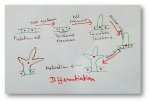Process of Digestion
We will discuss about the process of digestion and what happens to the undigested food.
Digestion starts in the mouth. The food is first broken into smaller pieces by our teeth when we chew it. The sharp teeth in front help us to bite and cut the food into smaller pieces. The back teeth are flat and help to grind the food into a paste.
The saliva is a digestive juice made by the salivary glands that mixes well with the food while chewing.
This softens the food so that the food can be easily swallowed. Saliva also starts breaking down starches into simpler soluble substances. Our tongue helps to mix the food with the saliva, and to push the food into the food pipe.
From mouth digestion continues in the stomach. The food goes to the stomach through the food pipe. The stomach muscles churn the food with more digestive juices. They break down proteins and other substances into simple soluble substances. The food remains in the stomach for upto three hours.
From the stomach, the food goes into a pipe called the small intestine. Here the food is mixed with more digestive juices and breaks down further. Some of these juices are made in the small intestine. Others are made in other body organs such as the liver and pancreas. These juices complete the digestion of food.
The food is now in a simple soluble form. It is absorbed into the blood through the walls of the small intestine. The blood takes it to all the cells in the body and then the digestion is completed in the small intestine.
So, digestion starts in the mouth, continues in the stomach and is completed in the small intestine.
Undigested food is thrown out of the body. Some parts of food cannot be digested by the body. They pass into a pipe called the large intestine. Here water is absorbed from the undigested food. The solid part is thrown out of the body as waste through the openings called the anus.
From Process of Digestion to HOME PAGE
Recent Articles
-
Differentiation, Dedifferentiation and Redifferentiation | Definition
Apr 21, 25 01:16 PM
Cells from the root apical meristem and shoot apical meristem the camera that differentiate , mature to perform different functions. This process by which the cells undergo different major structural… -
Explain about Growth in Plants |Definition of Growth & Differentiation
Feb 27, 25 02:07 PM
Growth is a permanent increase in length or volume of an organism that brought upon by an increase in its dimensions due to synthesis of new protoplasmic material. -
Definition of Respiratory Quotient | calculation | Application | Plant
Dec 02, 24 12:09 AM
Definition of respiration quotient- the ratio of the carbon-dioxide evolved to that of the oxygen consumed by a cell, tissue, plants or animals in a given time is called respiratory quotient. It is us… -
Amphibolic Pathway | Definition | Examples | Pentose Phosphate Pathway
Jun 06, 24 10:40 AM
Definition of amphibolic pathway- Amphibolic pathway is a biochemical pathway where anabolism and catabolism are both combined together. Examples of amphibolic pathway- there are different biochemical… -
Respiratory Balance Sheet | TCA Cycle | ATP Consumption Process
Feb 18, 24 01:56 PM
The major component that produced during the photosynthesis is Glucose which is further metabolised by the different metabolic pathways like glycolysis, Krebs cycle, TCA cycle and produces energy whic…





New! Comments
Have your say about what you just read! Leave me a comment in the box below.